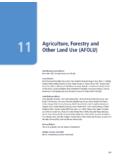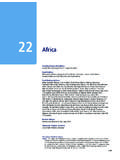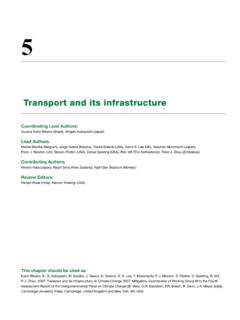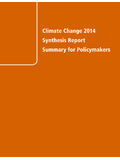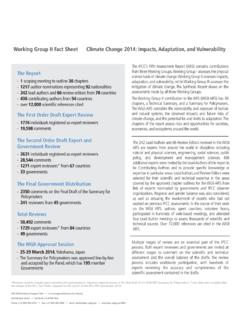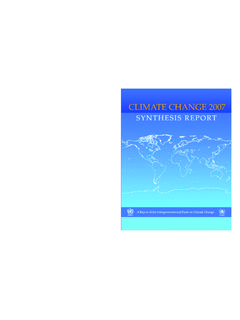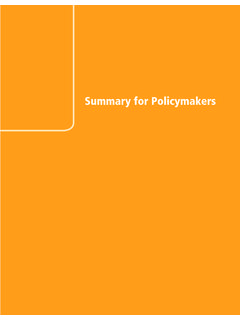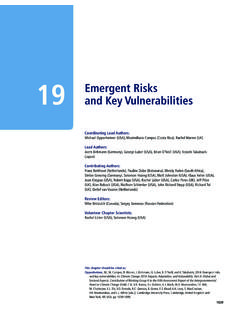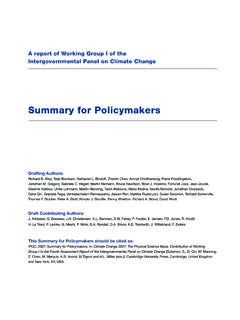Transcription of Summary for Policymakers - IPCC
1 Climate Change 2007:Synthesis ReportSummary for PolicymakersAn Assessment of the Intergovernmental Panel on Climate ChangeThis Summary , approved in detail at IPCC Plenary XXVII (Valencia, Spain, 12-17 November 2007), represents theformally agreed statement of the IPCC concerning key findings and uncertainties contained in the Working Groupcontributions to the Fourth Assessment on a draft prepared by:Lenny Bernstein, Peter Bosch, Osvaldo Canziani, Zhenlin Chen, Renate Christ, Ogunlade Davidson, William Hare, SaleemulHuq, David Karoly, Vladimir Kattsov, Zbigniew Kundzewicz, Jian Liu, Ulrike Lohmann, Martin Manning, Taroh Matsuno,Bettina Menne, Bert Metz, Monirul Mirza, Neville Nicholls, Leonard Nurse, Rajendra Pachauri, Jean Palutikof, MartinParry, Dahe Qin, Nijavalli Ravindranath, Andy Reisinger, Jiawen Ren, Keywan Riahi, Cynthia Rosenzweig, MatildeRusticucci.
2 Stephen Schneider, Youba Sokona, Susan Solomon, Peter Stott, Ronald Stouffer, Taishi Sugiyama, Rob Swart,Dennis Tirpak, Coleen Vogel, Gary YoheSummary for Policymakers2 IntroductionThis Synthesis report is based on the assessment carriedout by the three Working Groups of the IntergovernmentalPanel on Climate Change (IPCC). It provides an integratedview of climate change as the final part of the IPCC s FourthAssessment report (AR4).A complete elaboration of the Topics covered in this sum-mary can be found in this Synthesis report and in the under-lying reports of the three Working Observed changes in climate andtheir effectsWarming of the climate system is unequivocal, as isnow evident from observations of increases in globalaverage air and ocean temperatures, widespread melt-ing of snow and ice and rising global average sea level(Figure ).
3 { }Eleven of the last twelve years (1995-2006) rank amongthe twelve warmest years in the instrumental record of globalsurface temperature (since 1850). The 100-year linear trend(1906-2005) of [ to ] C1 is larger than the cor-responding trend of [ to ] C (1901-2000) given inthe Third Assessment report (TAR) (Figure ). The tem-perature increase is widespread over the globe and is greaterat higher northern latitudes. Land regions have warmed fasterthan the oceans (Figures , ). { , }Rising sea level is consistent with warming ( ).
4 Global average sea level has risen since 1961 at anaverage rate of [ to ] mm/yr and since 1993 at [ to ] mm/yr, with contributions from thermal expan-sion, melting glaciers and ice caps, and the polar ice the faster rate for 1993 to 2003 reflects decadal varia-tion or an increase in the longer-term trend is unclear. { }Observed decreases in snow and ice extent are also con-sistent with warming (Figure ). Satellite data since 1978show that annual average Arctic sea ice extent has shrunk [ to ]% per decade, with larger decreases in summerof [ to ]% per decade.
5 Mountain glaciers and snowcover on average have declined in both hemispheres. { }From 1900 to 2005, precipitation increased significantlyin eastern parts of North and South America, northern Europeand northern and central Asia but declined in the Sahel, theMediterranean, southern Africa and parts of southern , the area affected by drought has likely2 increasedsince the 1970s. { }It is very likely that over the past 50 years: cold days, coldnights and frosts have become less frequent over most landareas, and hot days and hot nights have become more is likely that: heat waves have become more frequent overmost land areas, the frequency of heavy precipitation eventshas increased over most areas, and since 1975 the incidenceof extreme high sea level3 has increased worldwide.
6 { }There is observational evidence of an increase in intensetropical cyclone activity in the North Atlantic since about 1970,with limited evidence of increases elsewhere. There is no cleartrend in the annual numbers of tropical cyclones. It is difficultto ascertain longer-term trends in cyclone activity, particularlyprior to 1970. { }Average Northern Hemisphere temperatures during thesecond half of the 20th century were very likely higher thanduring any other 50-year period in the last 500 years and likelythe highest in at least the past 1300 years.
7 { }Observational evidence4 from all continents and mostoceans shows that many natural systems are beingaffected by regional climate changes, particularly tem-perature increases. { }Changes in snow, ice and frozen ground have with high con-fidence increased the number and size of glacial lakes, increasedground instability in mountain and other permafrost regions andled to changes in some Arctic and Antarctic ecosystems. { }There is high confidence that some hydrological systemshave also been affected through increased runoff and earlierspring peak discharge in many glacier- and snow-fed riversand through effects on thermal structure and water quality ofwarming rivers and lakes.
8 { }In terrestrial ecosystems, earlier timing of spring eventsand poleward and upward shifts in plant and animal rangesare with very high confidence linked to recent warming. Insome marine and freshwater systems, shifts in ranges andchanges in algal, plankton and fish abundance are with highconfidence associated with rising water temperatures, as wellas related changes in ice cover, salinity, oxygen levels andcirculation. { }Of the more than 29,000 observational data series, from75 studies, that show significant change in many physical andbiological systems, more than 89% are consistent with thedirection of change expected as a response to warming (Fig-1 Numbers in square brackets indicate a 90% uncertainty interval around a best estimate, there is an estimated 5% likelihood that the valuecould be above the range given in square brackets and 5% likelihood that the value could be below that range.)
9 Uncertainty intervals are notnecessarily symmetric around the corresponding best in italics represent calibrated expressions of uncertainty and confidence. Relevant terms are explained in the Box Treatment of uncer-tainty in the Introduction of this Synthesis tsunamis, which are not due to climate change. Extreme high sea level depends on average sea level and on regional weathersystems. It is defined here as the highest 1% of hourly values of observed sea level at a station for a given reference largely on data sets that cover the period since for Policymakers (a) Global average surface temperature(b) Global average sea level(c) Northern Hemisphere snow coverFigure Observed changes in (a) global average surface temperature; (b) global average sea level from tide gauge (blue) and satellite(red) data and (c) Northern Hemisphere snow cover for March-April.
10 All differences are relative to corresponding averages for the period 1961-1990. Smoothed curves represent decadal averaged values while circles show yearly values. The shaded areas are the uncertainty intervalsestimated from a comprehensive analysis of known uncertainties (a and b) and from the time series (c). {Figure }Changes in temperature, sea level and Northern Hemisphere snow coverure ). However, there is a notable lack of geographicbalance in data and literature on observed changes, withmarked scarcity in developing countries.
